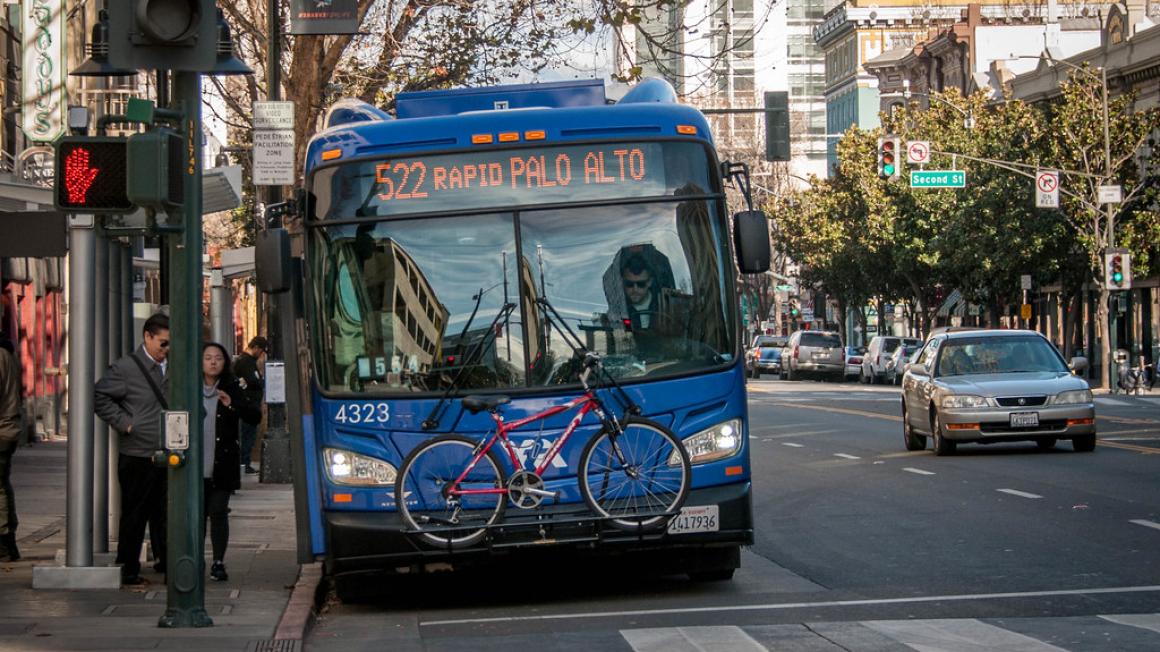Imagine riding the bus through downtown San Jose in your very own lane, passing cars that used to pass you, and watching lights turn green as you approach. The causes of delay that used to make the bus slow and unreliable—traffic congestion, red lights and waiting for traffic to clear to pull away from a bus stop—a thing of the past! We are now a little closer to that dream.
The “Move San José” plan, passed by the San José City Council August 9, 2022, declares San José a “Transit First City.” Its intent is to improve public transit access and the transit riding experience. Think of lanes just for buses and emergency vehicles so those vehicles aren’t snarled up in car traffic; and transit signal priority, fewer red lights and more green lights for approaching buses and light rail trains.
Under this new policy, any planning or street improvements where transit operates, must take into consideration how transit can be improved. On “grand boulevards,” which are streets that carry large volumes of transit riders, City planning staff will prioritize buses and trains over other road uses. That may mean changes like removing parking or general use lanes, to make space for public service lanes (for buses and emergency vehicles.)
The grand boulevards defined in the Envision 2040 San José General Plan are:
- North First Street/Monterey Road
- Capitol Avenue/Capitol Expressway
- Alum Rock Avenue/Santa Clara Street/The Alameda
- San Carlos Street/Stevens Creek Boulevard
- Meridian Avenue
- Winchester Boulevard
- Saratoga Avenue
A Change in Priorities
The Transit First policy marks a shift in street design priorities. For decades, San José prioritized moving people by car with wide streets, high travel speeds, and free and abundant parking. But when almost everyone drives, what you get is traffic jams, polluted air, buses that slog along in traffic, and streets that are dangerous for pedestrians and bicyclists.
The Move San José Plan seeks to shift travel modes in the city toward greener, more space-efficient travel and to make streets safer for all users. These goals are supported by the City’s Envision 2040 General Plan, Climate Smart Plan, Zero Emission 2030 Pledge, Paris Accords endorsement, Vision Zero goals, and equity goals.
To achieve those outcomes the incentives around how we travel need to evolve. Making transit faster, more frequent and more reliable will help make it a more appealing transit option and lead to increased use. When transit becomes faster, fewer buses or trains are needed to achieve the same frequency of service which frees up buses or trains to be deployed on new routes, with greater frequency or longer hours of service.
The flipside of increasing transit priority is reducing priority for other street users, namely cars, which is the travel mode that works against the City’s many goals. On corridors where transit operates and especially on Grand Boulevards, lanes for cars or street parking may be removed to install public service lanes. Transit signal priority may also be installed. These changes are expected to result in some opposition, as it will make driving less convenient, but maintaining the same incentives will result in the same outcomes.
VTA Buses are Getting Slower and Less Reliable
Average VTA bus speeds have declined by about 20% over the last three decades, a change that is likely the result of increased traffic congestion. The average VTA bus speed in 1988 was 14.1 miles per hour. In 2019, prior to the pandemic’s impact on travel behavior, VTA buses traveled 11.6 miles per hour. That slowdown has prompted VTA service planners to add more buses to routes increasing the cost of operation.
If VTA buses could recover the lost 2.5 miles per hour, VTA could save $70 million each year that could be reinvested in additional transit service in the form of increased frequency, new routes or expanded hours of service—essentially a 20 percent increase in service offered. Giving transit more priority so that it can avoid delays from traffic congestion and red lights will help VTA reverse the trend of declining transit appeal and increasing operating cost.
When Will Transit Priority Treatments Be Installed?
The Transit First Policy reflects the City’s intent to prioritize transit, where appropriate, in future efforts. It does not mean public service lanes or new signal timing will appear immediately. Rather, as funding, staff bandwidth and opportunities to improve streets arise, the policy will be applied. Changing how street space is allocated for cars and buses will require significant study and community engagement. Installing signal priority will require upgrading the technology in traffic signals and on buses and trains so that they can communicate with each other.
Big Questions Remain
How much transit priority is appropriate? What is the overall goal? Should transit be time-competitive with driving? Should a minimum average transit speed be achieved? Should different corridors have different goals? What are the causes of delay and which transit priority strategies best address them? What should be removed to make space for a public service lane?
The answers to these questions will vary on a corridor-by-corridor basis and the appropriate transit priority treatment(s) may vary from segment to segment. City staff and VTA staff will collaborate on these efforts and will seek community engagement along the way. Monterey Highway and Alum Rock/Santa Clara Street/The Alameda are among the first corridors that will be evaluated for transit priority treatments.

